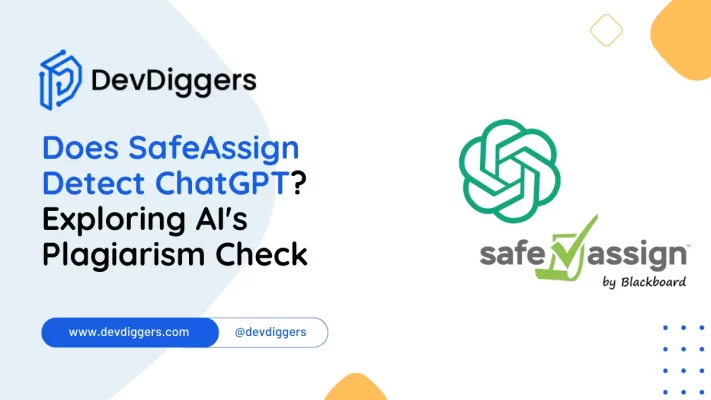Does SafeAssign Detect ChatGPT? Exploring AI’s Plagiarism Check

Regarding academic integrity, instructors and students frequently ask: Does SafeAssign detect ChatGPT?
As advances in AI, such as ChatGPT, transform the educational scene, analyzing the effectiveness of plagiarism detection techniques becomes critical.
This blog digs into the complexities of SafeAssign’s detection algorithms, including its ability to identify content created via ChatGPT.
Join us as we examine every aspect of this subject, illuminating academic integrity’s challenges and opportunities in the digital age.
Table of Contents
What is SafeAssign?

SafeAssign is a plagiarism detection tool commonly used in educational institutions to identify academic dishonesty.
Developed by Blackboard, SafeAssign compares submitted assignments against a vast database of academic papers, articles, and internet sources to pinpoint similarities or matches.
It helps educators ensure the originality of student work by highlighting potential instances of plagiarism or improper citation.
Through its algorithmic analysis, SafeAssign provides instructors with insights into the authenticity of student submissions, promoting academic integrity within learning environments.
Does SafeAssign Detect ChatGPT?

The question “Does SafeAssign detect ChatGPT?” revolves around whether the plagiarism detection tool.
SafeAssign is a plagiarism detection tool commonly used in educational institutions to check for originality in students’ work by comparing it to a vast database of academic content.
While SafeAssign can detect precise matches with publicly available sources and previously submitted student papers, its ability to see content generated by AI models like ChatGPT may vary.
Generally, SafeAssign may not explicitly identify text generated by AI models like ChatGPT as it may not have a specific database for such content.
However, SafeAssign can still detect plagiarism if the content generated by ChatGPT closely resembles existing academic material or if the student copies and pastes content from ChatGPT into their assignment without proper citation.
In essence, SafeAssign may not have a specific mechanism to identify text generated by ChatGPT and remove ChatGPT detection from the content.
Reasons Why SafeAssign Doesn’t Detect ChatGPT Content
The question “Does SafeAssign detect ChatGPT content?” arises from several reasons contributing to SafeAssign’s limitations in identifying text generated by ChatGPT:
- Unique Generation: ChatGPT generates text dynamically based on input prompts and its vast training dataset. Each output is impressive and not directly sourced from existing documents that SafeAssign typically checks against.
- Lack of Specific Database: SafeAssign primarily compares submitted work against a database of academic papers, articles, and previously submitted student assignments. It may not have a dedicated database containing content generated specifically by AI models like ChatGPT.
- No Prior Exposure: SafeAssign relies on pre-existing databases and patterns of plagiarism. Since ChatGPT is a relatively new technology, SafeAssign might not have been specifically trained to identify its outputs as potential plagiarism sources.
- Changing Output: ChatGPT’s responses can vary widely based on the input it receives and the parameters set by the user. This variability makes it challenging for SafeAssign to establish consistent patterns for detection.
- Dynamic Nature of AI: AI models like ChatGPT continuously evolve through updates and improvements. As a result, the characteristics of generated text may change over time, making it even more difficult for SafeAssign to detect such content reliably.
Overall, while SafeAssign is effective in identifying plagiarism from traditional sources, its current capabilities may not extend to efficiently detecting content generated by AI models like ChatGPT due to the unique nature and dynamic output of these systems.
What Can SafeAssign Detect?

Aside from your answer, “Does SafeAssign detect ChatGPT?”
SafeAssign offers a variety of detection activities. These detection features help detect plagiarism and unoriginal content in submitted academic work.
Below are some of the essential elements that SafeAssign can detect:
- Direct Copying: SafeAssign can identify instances where students directly copy and paste content from online sources, including websites, articles, and academic papers.
- Paraphrasing: It can detect attempts to paraphrase or rephrase existing text without proper citation. SafeAssign can flag sentence structure and wording similarities even if the words are changed.
- Quotations without Citation: SafeAssign can recognize text directly quoted from a source without proper citation or quotation marks.
- Self-Plagiarism: SafeAssign can identify instances where students submit work previously presented in other courses without proper citation or acknowledgment.
- Collaborative Plagiarism: It can detect cases where multiple students collaborate on an assignment but submit identical or highly similar work without proper acknowledgment.
- Mismatched Citations: SafeAssign can identify inconsistencies between in-text citations and the corresponding reference list, indicating potential plagiarism or improper citation practices.
Overall, SafeAssign is a tool for educators to promote academic integrity by identifying plagiarism and unoriginal content in student submissions.
Other Tools That Can Detect ChatGPT Content
As discussed above in the query on “Does SafeAssign detect ChatGPT?”
However, if you are looking for tools that specifically help in detecting ChatGPT content, then you can use the tools below:
1. Contentdetector.org
Contentdetector.org is a free, easy, and effective AI tool for identifying between humans and AI or ChatGPT written content with a single click.
2. Editpad AI Content Detector
The Editpad AI content detector is a free tool for detecting whether a piece of content is human-written. This program accurately verifies ChatGPT-generated content and Google Bard and Bing AI.
3. Originality.AI
Originality.AI is an advanced AI detector. It detects Chat GPT-4 texts with high accuracy (99%). It can recognize texts utilizing Chat GPT, GPT-2, GPT-3, GPT-4, and Bard.
4. Content At Scale AI Detector
Content at Scale is a dual-function tool that may be used as a free ChatGPT detector. It can identify AI-generated content because it is an AI detector. It can also produce content that bypasses other AI detection technologies.
5. Winston AI
Winston AI is another excellent free program that might assist you with the text’s AI probability. With a 99.6% accuracy percentage, Winston.AI is entirely accurate. Web publishers, educators, and writers can all benefit from it.
6. ZeroGPT
One well-liked free AI detection tool is ZeroGPT. ZeroGPT is a helpful tool for identifying and detecting content created by ChatGPT.
7. Turnitin
The AI Writing Detection feature on Turnitin is a relatively new technology.
It helps teachers identify unique information and is primarily used by colleges and high schools. Its accuracy rate in identifying plagiarism and artificial intelligence-generated grammar is 98%.
Final Thoughts on Does SafeAssign Detect ChatGPT
In conclusion, the query “Does SafeAssign detect ChatGPT?” highlights the connection between academic standards and technology.
SafeAssign is a useful tool for detecting plagiarism; however, it must be clarified if it can identify information created mainly by ChatGPT.
This confusion highlights how plagiarism detection is changing in light of advances in artificial intelligence.
Cooperation between educators, organizations, and developers is essential to find new answers to this problem in the future.
We must remain proactive in maintaining academic integrity as we navigate this changing environment and adjust to new technologies like ChatGPT.
